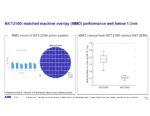At the VLSI Technology Symposium this week Intel released details on their i3 process. Over the last four nodes Intel has had an interesting process progression. In 2019, 10nm finally entered production with both high performance and high-density standard cells. 10nm went through several iterations eventually resulting in… Read More
Tag: 5nm
No! TSMC does not Make 90% of Advanced Silicon
Throughout the debate on fab incentives and the Chips Act I keep seeing comments like; TSMC makes >90% of all advanced silicon, or sometimes Taiwan make >90% of all advanced silicon. This kind of ill-defined and grossly inaccurate statement drives me crazy. I just saw someone make that same claim in the SemiWiki forums and… Read More
Pinning Down an EUV Resist’s Resolution vs. Throughput
The majority of EUV production is on 5nm and 3nm node, implemented by late 2022. Metal oxide resists have not been brought into volume production yet [1,2], meaning that only organic chemically amplified resists (CARs) have been used instead until now. These resists have a typical absorption coefficient of 5/um [3,4], which means
Is Intel cornering the market in ASML High NA tools? Not repeating EUV mistake
- Reports suggest Intel will get 6 of 10 ASML High NA tools in 2024
- Would give Intel a huge head start over TSMC & Samsung
- A big gamble but a potentially huge pay off
- Does this mean $4B in High NA tool sales for ASML in 2024?
News suggests Intel will get 6 of first 10 High NA tools made by ASML in 2024
An industry news source, Trendforce, reports… Read More
Cadence Integrates Power Integrity Analysis and Fix into Design
As integration levels increase, clock frequencies rise, and feature sizes shrink it is not surprising that all or most aspects of semiconductor design become more complex and demand more from design technologies. One example where the traditional approach is breaking down is in optimizing power distribution networks (PDNs)… Read More
ASML Update SEMICON West 2023
At SEMICON West I had a chance to catch up with Mike Lercel of ASML. In this article I am going to combine ASML presentation material from the SPIE Advanced Lithography Conference, Mike’s SEMICON presentation, my discussions with Mike at SEMICON and a few items from ASML’s recent earnings call.
DUV
ASML continues to improve DUV systems.… Read More
Applied Materials Announces “EPIC” Development Center
On May 22nd Applied Materials announced a new development center, Equipment and Process Innovation and Commercialization Center (EPIC).
Applied Materials already operates the Maydan Technology Center (MTC), a billion-dollar development facility with over 120 advanced process tools and 80 metrology and inspection tools… Read More
Alchip is Golden, Keeps Breaking Records on Multiple KPIs
I don’t know the story behind the name Alchip. I’ve been asking this question ever since its founding in 2003 and still haven’t found the answer. Wikipedia sometimes provides insights and stories behind names of companies, products and services but I couldn’t find any regarding the name Alchip. One thing is for sure. After its consistent… Read More
Synopsys Accelerates First-Pass Silicon Success for Banias Labs’ Networking SoC
Banias Labs is a semiconductor company that develops infrastructure solutions for next-generation communications. Its target market is the high-performance computing infrastructure market including hyperscale data center, networking, AI, optical module, and Ethernet switch SoCs for emerging high-performance computing… Read More
TSMC has spent a lot more money on 300mm than you think
Up until November of 2022, IC Knowledge LLC was an independent company and had become the world leader in cost and price modeling of semiconductors. In November 2022 TechInsights acquired IC Knowledge LLC and IC Knowledge LLC is now a TechInsights company.
For many years, IC Knowledge has published a database tracking all the 300mm… Read More











